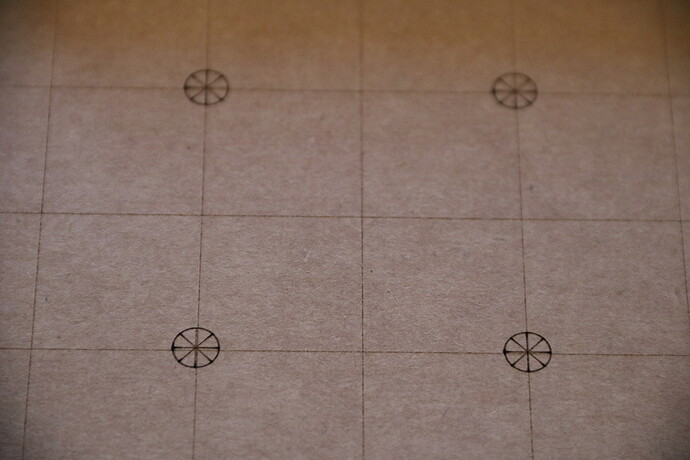I have never tested the accuracy of my camera, mostly because I have had great success with cutting small shapes out of scraps and never felt the need. I am also expecting that once the head camera is enabled we will have pretty extreme registration capabilities. This thread has peaked my interest in the exact tolerance of my bed camera however, so I decided to run some tests.
I created a 1" grid pattern and scored onto some scrap cardboard. The cardboard was not a very good test material however because it had both bowing/warping issues as well as I measured pretty inconsistent thicknesses ranging from .16" to .175. I used .17" as my initial value for the focus height. I placed magnets around the parameter in an effort to minimize warping issues, but there was still some areas hovering above the bed.
Bed image before scoring, focus set to .17"
Bed image after scoring (no shifting of the grid), focus still set to .17". I could see some minor shifting so I started playing around with focus settings. I found .15" got pretty close to an overlap of the scores and the vector grid.
Bed image after adjusting focus to .15". I decided to bring in a target point to try to line up and then score over the grid lines now on the cardboard. I placed each one individually by eye at 200% zoom in the GFUI.
Bed image with focus at .15" and all the target points placed by eye.
Bed image after scoring targets. Focus still set to .15".
Bed image with new targets (no circles) focus now set back to .17".
Bed image with new targets scored. There was more of a visible shift for sure.
Photo of results.
Worst case, focus set at .17". Offset less than 1/8".
Focus set to .15". Offset less than 1/16".
Finally a shot of the four most central targets.
This test would have been more meaningful with a more consistent material like Proofgrade. That being said, should anyone wish to try to replicate on their end I will provide my SVG files.
TestGridSVGs.zip (1.9 KB)
